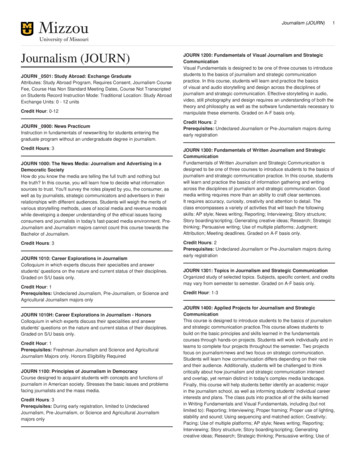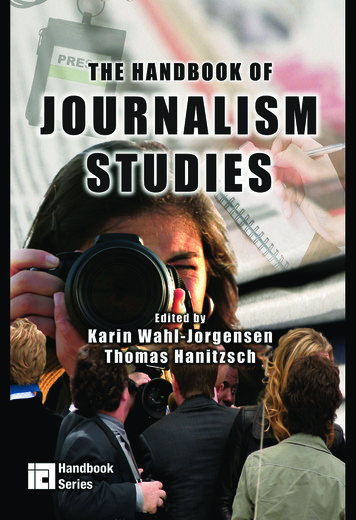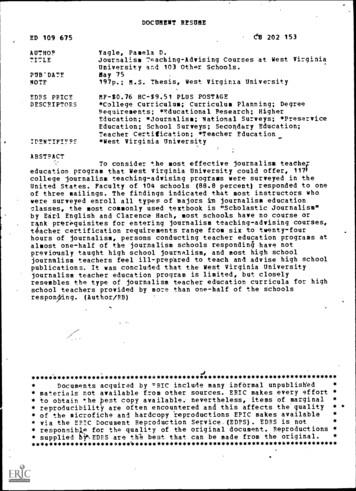Journalism And Media Management - University Of Miami
Journalism and Media Management1JOURNALISM AND MEDIA MANAGEMENThttp://com.miami.edu/programsThe Department of Journalism and Media Management offers majors in Broadcast Journalism, Electronic Media, Journalism and Media Managementand minors in Broadcast Journalism, Electronic Media, Hispanic Media, Journalism and Media Management.Dept. Code: JMMIntroductionThe Department of Journalism and Media Management emphasizes hands-on learning and critical thinking within a multicultural, international context.Our students consistently win regional and national awards, and obtain prestigious internships and long-term positions in a competitive mediamarketplace. Additionally, they are meeting the challenges of the evolving media industry through entrepreneurial leadership. Our graduates also gainadmission to excellent graduate programs and professional schools in a variety of fields.Four majors and five minors are offered in the Department of Journalism and Media Management. The department's programs attract students interestedin working in these specific fields, but also provide strong writing, creative, and analytical skills to students who pursue careers in other fields, such aslaw and business.The School of Communication’s Electronic Media and Broadcast Journalism majors are designed for students who intend to pursue professional workin electronic news, production operations and allied fields.Students majoring or minoring in these subjects study all aspects of television, radio, cable, broadband, digital and mobile operations. All BroadcastJournalism and Electronic Media students are encouraged to become involved in UMTV (the campus cable television channel available to the community,the UM campus and over the web) and the student-run radio station, WVUM-FM, serving South Florida.The School's Media Management major is designed for students interested in the business and management aspects of contemporary media. Studentsmay pursue interests in entrepreneurship, sales, management, technology and research, among other topics. Students are encouraged to network withindustry professionals at Media Management Association meetings and expand their knowledge of media business operations on various platformsthrough local and national internships.The School's major in Journalism prepares students to be writers, editors and designers for a variety of media from mainstream and alternativenewspapers and magazines to online media and entrepreneurial ventures. We emphasize effective storytelling through writing, audio and video recording,photography, graphics and data visualization. Reporting skills, analytical thinking and journalistic ethics are stressed throughout the program. Studentsare encouraged to work for The Miami Hurricane, the student-run newspaper, Distraction magazine and the Ibis yearbook, all of which are nationally awardwinning publications. The robust South Florida media market also provides off-campus opportunities at various professional publications and websites.Students majoring in Journalism may concentrate their studies in one of several tracks or areas or they may customize their course of study. Thesuggested tracks include: Reporting and Writing (which is the general journalism or custom track); Media and Journalism Studies (a more conceptualand less applied track for students interested in media analysis); Visual and Documentary Journalism (which allows for the study of photography, webdesign and videography or documentaries); and Sports, Travel and Lifestyle Features (which focuses on these as related areas of content). These tracksallow students the flexibility to design programmatic concentrations in everything from writing to web design to documentary and visual storytelling.The School's facilities include a state-of-the-art radio studio, two high-definition television studios, digital post-production suites and related capabilities.Major Cognate Area Broadcast Journalism People and Society Electronic Media People and Society Journalism People and Society Media Management People and SocietyMinor Cognate Area Broadcast Journalism People and Society Electronic Media People and Society Hispanic Media
2Journalism and Media Management People and Society Journalism People and Society Media Management People and SocietyDegree ProgramsThe Bachelor of Science in Communication is offered in Journalism, Electronic Media, Broadcast Journalism, and Media Management.MajorMajors are offered in: Electronic Media Broadcast Journalism Media Management JournalismEach candidate for the degree of Bachelor of Science in Communication will complete School of Communication requirements including courses inthe School’s General Education Required Areas of Study. All majors must also complete a separate minor or second major within the School or in anacademic program outside the School.NOTE: Departmental Majors, if you wish to double major in the Department of Journalism and Media Management, you must first obtain the writtenapproval of the JMM Department Chair.Admission to the Electronic Media, Broadcast Journalism, Media Management and Journalism MajorsBefore admission as an Electronic Media, Broadcast Journalism, Media Management or Journalism major, a student must: Complete the Core courses listed below, in residence at the University, all with grades of C or higher (C- is not acceptable). Students who have obtained the written approval of the Chair of Journalism and Media Management to use transfer credit hours to satisfy one ormore requirements of that major may be required to complete additional courses in residence at the University before being admitted to that major. Upon completion of a student’s first 45 University credit hours while enrolled in the School of Communication, all University credit hours earnedtoward the major will be used in computing a student’s major cumulative grade point average; only those students with a cumulative average of2.5 or higher will be admitted to a major. A student who has completed 45 credit hours while enrolled in the School of Communication, but who has not been admitted to one of theCommunication majors, may be dismissed from the School. A student who has completed 60 University credit hours while enrolled in the School,but who has not been admitted to one of the Communication majors, will be dismissed from the School.JMM 102. Understanding Media and Content in the Digital Age. 3 Credit Hours.This course examines how traditional and new media industries are economically structured and how various media content influences audiences andculture. Historical, technological, and regulatory issues related to the different media platforms will also be discussed from a comparative perspective.Components: LEC.Grading: GRD.Typically Offered: Fall & Spring.JMM 106. Visual Design. 3 Credit Hours.This course is an introduction to the principles of design, typography, color theory, usability and interactivity as they apply to the layout and design ofcontent for print and digital media.Components: LEC.Grading: GRD.Typically Offered: Fall & Spring.JMM 108. Writing for the Digital Age. 3 Credit Hours.This course provides students with an understanding of writing styles appropriate for communicating in the digital age, with particular emphasison grammar, spelling, syntax and clarity. It provides a solid foundation for further practice and specialization in various types of multimediacommunication.Components: LEC.Grading: GRD.Typically Offered: Fall & Spring.
Journalism and Media Management3JMM 206. Special Topics in Journalism and Media Management I. 3 Credit Hours.This course subject matter varies according to announced special topics. See class schedule for details.Components: LEC.Grading: GRD.Typically Offered: Offered by Announcement Only.JMM 208. Fundamentals of Newsgathering. 3 Credit Hours.Skill development in gathering facts and other material for, and in preparation of, news stories in a variety of genres across platforms. Focus ongathering information from multiple sources, analyzing and organizing information for dissemination, and presenting the most pertinent facts clearlyand cohesively to multiple media outlets.Prerequisites: JMM 111 or JMM 108.Components: LEC.Grading: GRD.Typically Offered: Fall & Spring.JMM 210. Writing About the Arts. 3 Credit Hours.The aim of JMM 210 is to help you develop skills in writing and reporting about entertainment and the arts.Components: LEC.Grading: GRD.Typically Offered: Offered by Announcement Only.JMM 221. Introduction to Documentary Photography. 3 Credit Hours.Course is designed to develop skills in visual storytelling. Students will learn to produce images and recognize what makes good photographs in termsof content, composition, and technical quality.Components: LEC.Grading: GRD.Typically Offered: Fall & Spring.JMM 233. Television Performance. 3 Credit Hours.Introduction to communication concepts and skills involved in on-camera duties such as anchoring, interviewing and live reporting.Components: LEC.Grading: GRD.Typically Offered: Offered by Announcement Only.JMM 235. Radio Production and Performance. 3 Credit Hours.Introduction to equipment and procedures of radio. Production of radio programs and formats, editing, announcing, sequencing program elements,and designing program formulas are discussed.Components: LEC.Grading: GRD.Typically Offered: Spring.JMM 245. Introduction to Electronic Media Production. 3 Credit Hours.Introduction to the theory, process, and procedure of electronic media production. Lecture and laboratory are included.Components: LEC.Grading: GRD.Typically Offered: Fall & Spring.JMM 285. Applied Statistics for Journalism and Media Management. 3 Credit Hours.This course provides students an introduction to descriptive and bivariate inferential statistics to better understand and use media research andanalysis. Computer applications are included.Prerequisite: MTH 101 or ALEKS Score 60 or Math SAT 630 or Math ACT 28.Components: LEC.Grading: GRD.Typically Offered: Fall.JMM 300. Journalism Practicum. 1-3 Credit Hours.Prescribed study and supervised work with faculty and staff of the student news paper or related news media. Students receive first-hand knowledgeand experience in a working news environment.Components: PRA.Grading: GRD.Typically Offered: Fall & Spring.
4Journalism and Media ManagementJMM 301. Media Research and Analysis. 3 Credit Hours.Survey of qualitative and quantitative research methods used to collect and analyze data on media audiences. Course also covers metrics used bymedia industries. Practice in conducting small-scale audience measurement is included.Pre-requisite: JMM 102.Components: LEC.Grading: GRD.Typically Offered: Fall & Spring.JMM 302. Electronic Media Law. 3 Credit Hours.Course provides analysis of laws and other forces that influence broadcasting, cable, and online media operations. Examines the application of theFirst Amendment to media operations with a focus on press law.Components: LEC.Grading: GRD.Typically Offered: Fall & Spring.JMM 303. Communication Law and Policy. 3 Credit Hours.A study of First Amendment law and theories concerning libel, privacy, copyright, advertising, corporate communications, reporter privilege, freepress/fair trial, pornography, access to government information, broadcasting and new communication technologies. Discussion of internationalperspectives on media regulationPrerequisite: JMM 102.Components: LEC.Grading: GRD.Typically Offered: Fall, Spring, & Summer.JMM 304. Web and Media Analytics. 3 Credit Hours.This course covers the computations, interpretations, and applications of metrics used to measure media audiences across electronic, print, andonline platforms.Components: LEC.Grading: GRD.Typically Offered: Fall & Spring.JMM 305. Legal Issues in Media Management. 3 Credit Hours.Examination of the legal environment affecting contemporary media businesses including broadcasting, advertising, public relations, web-basedmedia, and print publications. Focus on U.S. law, with introduction of international and comparative perspectives.Requisite: Sophomore Standing or Higher.Components: LEC.Grading: GRD.Typically Offered: Spring.JMM 306. Special Topics in Journalism and Media Management II. 3 Credit Hours.This course subject matter varies according to announced special topics. See class schedule for details.Requisite: Sophomore Standing or Higher.Components: LEC.Grading: GRD.Typically Offered: Offered by Announcement Only.JMM 307. Mobile Journalism. 3 Credit Hours.This course provides an introduction to the fundamental procedures in the production and development of mobile storytelling.Components: LEC.Grading: GRD.Typically Offered: Fall & Spring.JMM 309. Data Journalism. 3 Credit Hours.This course teaches how to extract meaning from data for more powerful reporting.Components: LEC.Grading: GRD.Typically Offered: Offered by Announcement Only.JMM 313. Media Sales. 3 Credit Hours.Operation of sales departments within media outlets. Course includes the preparation and delivery of sales presentations as well as the use ofaudience reports.Prerequisite: JMM 102.Components: LEC.Grading: GRD.Typically Offered: Fall.
Journalism and Media Management5JMM 314. Media Programming. 3 Credit Hours.Course covers categories and sources for selecting program materials used in radio, television, cable television, and other program services.Strategies employed in devising program schedules and understanding audience behaviors are also covered.Components: LEC.Grading: GRD.Typically Offered: Fall & Spring.JMM 317. Broadcast Journalism. 3 Credit Hours.Preparation of materials for presentation through the broadcast/cable media with emphasis on news writing for oral presentation by studio anchorsand field reporters. Course examines issues facing the profession of broadcast journalism, radio, and TV reporting techniques and news programformats.Prerequisite: JMM 108 and JMM 208 and JMM 245.Components: LEC.Grading: GRD.Typically Offered: Fall & Spring.JMM 319. History of Journalism. 3 Credit Hours.The development and impact of American journalism.Components: LEC.Grading: GRD.Typically Offered: Fall.JMM 331. Introduction to Infographics and Data Visualization. 3 Credit Hours.This course is an introduction to the visual display of information with a special focus on the encoding of data by means of graphs, charts, maps, anddiagrams.Components: LEC.Grading: GRD.Typically Offered: Fall & Spring.JMM 333. Social Media and Journalism. 3 Credit Hours.Examination of best practices for use of social media for gathering, disseminating, and promoting information.Components: LEC.Grading: GRD.Typically Offered: Spring.JMM 341. Web Design. 3 Credit Hours.This course covers the basic aspects of interaction design and web development, focusing on production processes. It provides an overview of webdesign concepts including usability, accessibility, information architecture, basic animation, and graphic design; all discussed in the context of the webenvironment. This course further offers an introduction to fundamental and emerging web trends.Components: LEC.Grading: GRD.Typically Offered: Fall & Spring.JMM 345. Intermediate Electronic Media Production. 3 Credit Hours.Planning and execution of complex field, studio, and multimedia production in a variety of lengths and formats. High level skills in television controlroom situations and non-linear editing will be used to produce audio, video, and online content.Prerequisite: JMM 245.Components: LEC.Grading: GRD.Typically Offered: Fall & Spring.JMM 361. Advanced Documentary Photography. 3 Credit Hours.Advanced Documentary Photography is a class designed to improve the visual storytelling news gathering, and photographic technical skillsintroduced in the introductory course.Prerequisite: JMM 221.Components: LEC.Grading: GRD.Typically Offered: Fall & Spring.JMM 381. Newspaper Editing and Layout. 3 Credit Hours.Introduction to electronic editing and development of skills in copy editing, headline writing, picture editing, and newspaper layout.Prerequisite: JMM 208.Components: LEC.Grading: GRD.Typically Offered: Fall.
6Journalism and Media ManagementJMM 382. Publication Planning and Editing. 3 Credit Hours.Introduction to editing and design, with emphasis on the development of skills in editing copy and photos, writing headlines, news judgment, anddesigning print publications and websites.Prerequisites: JMM 216 or JMM 208, JMM 106.Components: LEC.Grading: GRD.Typically Offered: Offered by Announcement Only.JMM 401. Editorial Interpretation of Contemporary Events. 3 Credit Hours.Critical examination of fundamental issues in public life. Preparation of editorials and interpretive articles for mass media are included.Prerequisites: JMM 216 or JMM 208.Components: LEC.Grading: GRD.Typically Offered: Offered by Announcement Only.JMM 402. Strategic Media Management. 3 Credit Hours.This course focuses on strategy analysis, formulation, implementation, and evaluation in managing media enterprises. Media cases are used to applyand discuss strategies.Pre-requisite: JMM 102.Components: LEC.Grading: GRD.Typically Offered: Fall & Spring.JMM 403. Media Industry Trends. 3 Credit Hours.This course examines the organizational and economic issues that influence today's mass media environment.Requisite: Junior Status.Components: LEC.Grading: GRD.Typically Offered: Fall.JMM 404. Latinos and the Media. 3 Credit Hours.This course examines the history, politics, production and reception of Latino-oriented media. It considers Latino media production processes, as wellas Latina/o audiences’ immigration, incorporation and media reception patterns. The course takes advantage of Miami as a vibrant immigration mediaproduction site through field trips and independent research projects.Requisite: Sophomore Standing or Higher.Components: LEC.Grading: GRD.Typically Offered: Spring.JMM 406. Special Topics in Journalism and Media Management III. 3 Credit Hours.This course subject matter varies according to announced special topics. See class schedule for details.Components: LEC.Grading: GRD.Typically Offered: Offered by Announcement Only.JMM 407. Media Entrepreneurship. 3 Credit Hours.Students generate comprehensive business plans for a proposed media enterprise. Organizational, financial, and marketing aspects of starting amedia business are discussed.Requisite: Senior Standing.Components: LEC.Grading: GRD.Typically Offered: Fall & Spring.JMM 408. International Electronic Media Systems. 3 Credit Hours.Seminar on world broadcasting systems and trans-national communication services. Discussion of contemporary issues involving electronic mediasystems worldwide.Requisite: Junior Status or Permission of Instructor.Components: LEC.Grading: GRD.Typically Offered: Fall.
Journalism and Media Management7JMM 409. Advanced Feature Design. 3 Credit Hours.Advanced newspaper, magazine, and electronic design. Students will develop the skills necessary to produce strong visual packages combining type,photography, artwork, and white space. The course will cover advanced design and traditional reproduction techniques for art and copywriting as wellas on-line presentations.Prerequisite: JMM 106. Or STC 202. Or STC 203.Components: LEC.Grading: GRD.Typically Offered: Fall.JMM 414. Evolution and Impact of Television Content: The American Sitcom. 3 Credit Hours.The seminar will examine how social, economic and political factors impacted the development and evolution of the content of sitcoms, as well as theimpact such content had on American society.Components: LEC.Grading: GRD.Typically Offered: Fall & Spring.JMM 417. Advanced Broadcast Journalism. 3 Credit Hours.This capstone course concentrates on gathering and preparing news stories for presentation in news programs. Includes field reporting, editing,preparation of visual and aural TV elements, writing, producing and performing fo
Journalism and Electronic Media students are encouraged to become involved in UMTV (the campus cable television channel available to the community, the UM campus and over the web) and the student-run radio station, WVUM-FM, serving South Florida.
Journalism, Pre-Journalism, or Science and Agricultural Journalism majors only JOURN 1200: Fundamentals of Visual Journalism and Strategic Communication Visual Fundamentals is designed to be one of three courses to introduce students to the basics of journalism and strategic communication practice.
journalism as it relates to lifestyle journalism, as both have been shown to be, in many ways, driven by the audience. Lifestyle Journalism. In lifestyle journalism, journalistic doxa and journalistic habitus are created vis-à-vis a relationship with the audience. Furthermore, this relationship helps build social capital (Fürsich 2013).
As such, The Handbook of Journalism Studies is a must-have resource for scholars and graduate students working in journalism, media studies, and communication around the globe. A Volume in the International Communication Association Handbook Series. Karin Wahl-Jorgensen is Reader in the Cardiff School of Journalism, Media, and Cultural Stud-
Journalism 5606W: Literary Aspects of Journalism Nancy Roberts This is a graduate-level course that studies the literary aspects of journalism as exemplified in, and influenced by, works of British and American writers, past and present. These include such writers as: Daniel Defoe, Charles Dickens, William Hazlitt, Samuel Clemens, Stephen Crane,
Enumerate Hickey’s role in the Indian journalism. 8. Do you think Hickey laid the foundation of Print journalism in India? Give your reasons. 9. “James Augustus Hickey is regarded as the father of Indian journalism “ – Discuss. 10. Compare J.A.Hickey and J.S.Buckinghum in developing Indian journalism. 11.
investigative reporting) as a distinctive news genre or news style and this article urges that it receive more attention. Keywords Contextual journalism, explanatory journalism, interpretive journalism, investigative journalism, news paradigm, politi
Practical Journalism. Most universities have their own studio, computer laboratory and reporters' facilities. The Journalism Higher Education Organization of Mongolia supported the publication in 2010 of the Mongolian language version of the unesco series on journalism education entitled Model Curricula for Journalism
University of Maine Suffolk University Central Michigan University University of Michigan Michigan State University University of Minnesota Moorhead State College . Grant M. Hyde, "Journalism in the High School," The Journalism Bulletin (now Journalism. Ouarterly), Vol. 2 (New Series), No. 1























